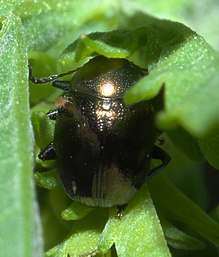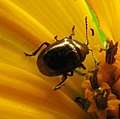Brachypnoea
Brachypnoea is a genus of leaf beetles in the subfamily Eumolpinae. It is mostly found in the Neotropical realm, though there are also eight known species in the Nearctic realm.[5][6][7][8]
| Brachypnoea | |
|---|---|
 | |
| Brachypnoea | |
| Scientific classification | |
| Kingdom: | Animalia |
| Phylum: | Arthropoda |
| Class: | Insecta |
| Order: | Coleoptera |
| Family: | Chrysomelidae |
| Subfamily: | Eumolpinae |
| Tribe: | Eumolpini |
| Genus: | Brachypnoea Gistel, 1848[1] |
| Type species | |
| Colaspis tristis Olivier, 1808 | |
| Synonyms[2] | |
The genus was originally named Noda, named by Chevrolat in Dejean's Catalogue in 1836. However, this was preoccupied by Noda Schellenberg, 1803, a genus in Diptera. Two replacement names were made for Noda: Brachypnoea, by Gistel in 1848, and Nodonota by Édouard Lefèvre in 1885. Since Brachypnoea was published first, it has priority over Nodonota.[2]
Species
These species belong to the genus Brachypnoea:[5][7][6][9][10][11]
- Brachypnoea acuminata (Lefèvre, 1885)[4]
- Brachypnoea acutangula (Jacoby, 1890)
- Brachypnoea angulicollis (Lefèvre, 1876)
- Brachypnoea arbustorum Bechyné & Bechyné, 1961[12]
- Brachypnoea argentiensis (Jacoby, 1904)
- Brachypnoea atra (Harold, 1875)
- Brachypnoea aurulenta (Lefèvre, 1876)
- Brachypnoea balyi (Jacoby, 1878)
- Brachypnoea basalis (Jacoby, 1890)
- Brachypnoea bebedera (Bechyné, 1955)[13]
- Brachypnoea bella (Jacoby, 1890)
- Brachypnoea bicallosa (Jacoby, 1881)
- Brachypnoea boggianii (Jacoby, 1899)
- Brachypnoea bogotana (Harold, 1874)
- Brachypnoea boliviana (Jacoby, 1899)
- Brachypnoea bowdichi (Bechyné, 1949)
- Brachypnoea callosa (Lefèvre, 1878)[16]
- Brachypnoea carpintera (Bechyné, 1955)[13]
- Brachypnoea chalcea (Lefèvre, 1878)[16]
- Brachypnoea chontalensis (Jacoby, 1890)
- Brachypnoea clypealis (Horn, 1892)[17]
- Brachypnoea colaspisformis (Bechyné, 1949)
- Brachypnoea colonensis (Bechyné, 1955)[13]
- Brachypnoea columbina (Lefèvre, 1878)[16]
- Brachypnoea congregata (Jacoby, 1890)
- Brachypnoea consonaria (Bechyné, 1951)
- Brachypnoea convexa (Say, 1824)
- Brachypnoea coroicensis (Bechyné, 1951)
- Brachypnoea costipennis (Lefèvre, 1875)
- Brachypnoea cretifera (Lefèvre, 1875)
- Brachypnoea cribellata (Jacoby, 1881)
- Brachypnoea cupriceps (Lefèvre, 1877)[18]
- Brachypnoea cyanella (Jacoby, 1890)
- Brachypnoea cyanescens (Weise, 1921)[3]
- Brachypnoea denticollis (Jacoby, 1899)
- Brachypnoea dispersa (Jacoby, 1881)
- Brachypnoea distincta (Jacoby, 1881)
- Brachypnoea doryphthalma (Bechyné, 1954)[15]
- Brachypnoea doryphthalma doryphthalma (Bechyné, 1954)
- Brachypnoea doryphthalma quimensis Bechyné, 1958[19]
- Brachypnoea edura (Weise, 1921)[3]
- Brachypnoea elongata (Jacoby, 1890)
- Brachypnoea eulina Bechyné & Bechyné, 1961[12]
- Brachypnoea exilis (Erichson, 1848)
- Brachypnoea fallaciosa (Weise, 1921)[3]
- Brachypnoea fastidita (Jacoby, 1899)
- Brachypnoea filicornis (Weise, 1921)[3]
- Brachypnoea floricola (Bechyné, 1949)
- Brachypnoea freyi (Bechyné, 1951)
- Brachypnoea fulvicornis (Jacoby, 1890)
- Brachypnoea grenadensis (Jacoby, 1897)
- Brachypnoea hondurensis (Jacoby, 1890)
- Brachypnoea humeralis (Latreille, 1833)[14]
- Brachypnoea humlis (Erichson, 1848)
- Brachypnoea igneicollis (Jacoby, 1881)
- Brachypnoea imitans (Jacoby, 1890)
- Brachypnoea insignis (Lefèvre, 1885)[4]
- Brachypnoea interrupta (Weise, 1921)[3]
- Brachypnoea irazuensis (Jacoby, 1881)
- Brachypnoea junonis (Bechyné, 1952)[20]
- Brachypnoea laeta (Lefèvre, 1878)[16]
- Brachypnoea laevicollis (Jacoby, 1881)
- Brachypnoea landolti (Lefèvre, 1878)[16]
- Brachypnoea lateralis (Jacoby, 1881)
- Brachypnoea lecontei E. Riley, S. Clark & Seeno, 2003
- Brachypnoea lefevrei (Jacoby, 1878)
- Brachypnoea longicornis (Bechyné, 1953)[9]
- Brachypnoea lugens (Weise, 1921)[3]
- Brachypnoea luteipes (Lefèvre, 1878)[16]
- Brachypnoea margaretae (Schultz, 1980)[21]
- Brachypnoea medellina (Lefèvre, 1878)[16]
- Brachypnoea meligethoides (Weise, 1921)[3]
- Brachypnoea meridensis (Bechyné, 1953)[9]
- Brachypnoea metallica (Jacoby, 1890)
- Brachypnoea micromela (Bechyné, 1953)[9]
- Brachypnoea mimas (Bechyné, 1955)[13]
- Brachypnoea minuta (Jacoby, 1881)
- Brachypnoea miribella (Bechyné, 1951)
- Brachypnoea mixiollensis (Bechyné, 1954)[15]
- Brachypnoea modesta (Lefèvre, 1878)[16]
- Brachypnoea moerens (Weise, 1921)[3]
- Brachypnoea moesta (Weise, 1921)[3]
- Brachypnoea nana (Klug, 1829)
- Brachypnoea nicandra (Bechyné, 1953)[9]
- Brachypnoea nigra (Weise, 1921)[3]
- Brachypnoea obliterata (Jacoby, 1890)
- Brachypnoea ocanana (Lefèvre, 1878)[16]
- Brachypnoea opaca (Jacoby, 1881)
- Brachypnoea opacicollis (Jacoby, 1890)
- Brachypnoea ovoidea (Bechyné, 1953)[9]
- Brachypnoea palmarensis (Bechyné, 1951)
- Brachypnoea paraensis Bechyné & Bechyne, 1961[22]
- Brachypnoea peregrina (Lefèvre, 1878)[16]
- Brachypnoea phryna (Bechyné, 1953)[9]
- Brachypnoea piccolina Bechyné & Bechyné, 1964[23]
- Brachypnoea placida (Jacoby, 1890)
- Brachypnoea plumbea (Jacoby, 1890)
- Brachypnoea puncticollis (Say, 1824) (rose leaf beetle)
- Brachypnoea purpureosericea (Bechyné, 1951)
- Brachypnoea pustulata (Harold, 1874)
- Brachypnoea rotundicollis (Schaeffer, 1906)[24]
- Brachypnoea ruficornis (Lefèvre, 1885)[4]
- Brachypnoea rufipes (Lefèvre, 1878)[16]
- Brachypnoea rufula (Weise, 1921)[3]
- Brachypnoea scheerpelzi (Bechyné, 1955)[13]
- Brachypnoea scutellaris (Lefèvre, 1878)[16]
- Brachypnoea secondaria (Bechyné, 1951)
- Brachypnoea secondaria secondaria (Bechyné, 1951)
- Brachypnoea secondaria sculptithorax (Bechyné, 1953)[9]
- Brachypnoea selenaria (Bechyné, 1951)
- Brachypnoea semicostata (Lefèvre, 1875)
- Brachypnoea seminigra (Lefèvre, 1891)[25]
- Brachypnoea sermyla (Bechyné, 1955)[13]
- Brachypnoea sinuata (Jacoby, 1890)
- Brachypnoea spinulosa (Lefèvre, 1885)[4]
- Brachypnoea strangulata (Bechyné, 1951)
- Brachypnoea subcylindrica (Jacoby, 1881)
- Brachypnoea sylvana (Bechyné, 1953)[9]
- Brachypnoea tarsata (Jacoby, 1881)
- Brachypnoea texana (Schaeffer, 1919)[26]
- Brachypnoea theobromae (Bryant, 1924)[27]
- Brachypnoea tricostulata (Lefèvre, 1875)
- Brachypnoea tristis (Olivier, 1808)
- Brachypnoea unicostata (Jacoby, 1881)
- Brachypnoea varicornis (Weise, 1921)[3]
- Brachypnoea venustula (Lefèvre, 1878)
- Brachypnoea violaceipennis (Jacoby, 1878)
- Brachypnoea virginia (Bechyné, 1955)[13]
- Brachypnoea virgulata (Lefèvre, 1878)[16]
- Brachypnoea viridis (Jacoby, 1878)
- Brachypnoea vulnerata Bechyné & Bechyne, 1961[22]
- Brachypnoea wanda (Bechyné, 1954)[28]
- Brachypnoea weyrauchi (Bechyné, 1955)[13]
- Brachypnoea winkerli (Lefèvre, 1878)[16]
- Brachypnoea wygodzinskyi (Bechyné, 1949)
- Brachypnoea zita (Bechyné, 1954)[28]
Species moved to Dryadomolpus:[14]
- Brachypnoea brevis (Lefèvre, 1889)[19] (originally in Alethaxius)
- Brachypnoea ella (Bechyné, 1955)[13]
- Brachypnoea simoni (Lefèvre, 1889)
- Brachypnoea singularis (Lefèvre, 1889)
- Brachypnoea trichophora (Bechyné, 1955)[13]
Synonyms:
- Brachypnoea chrysicollis (Weise, 1921):[3] Synonym of Brachypnoea aurulenta (Lefèvre, 1876)[13]
- Brachypnoea coeruleata (Jacoby, 1899): Synonym of Brachypnoea venustula (Lefèvre, 1878)[12]
- Brachypnoea granosa (Lefèvre, 1885):[4] Synonym of Brachypnoea nana (Klug, 1829)[29]
- Brachypnoea venezuelensis (Jacoby, 1899): Synonym of Brachypnoea humeralis (Latreille, 1833)[14]
Gallery
 Brachypnoea sp. on sunflower
Brachypnoea sp. on sunflower
gollark: Compared to what?
gollark: Maybe Rust with nicer syntax.
gollark: I can extend it into the realm of complex numbers; that'd actually be fun.
gollark: Making infipage 2D?
gollark: Let's write a python interpreter in haskell.
References
- Bezděk, J. (2020). "Review of the genus-level names proposed by Johannes Gistel in Chrysomelidae (Coleoptera)". Acta Entomologica Musei Nationalis Pragae. 60 (1): 173–188. doi:10.37520/aemnp.2020.011.
- Flowers, R. W.; Furth, D. G.; Thomas, M. C. (1994). "Notes on the Distribution and Biology of Some Florida Leaf Beetles (Coleoptera: Chrysomelidae)". The Coleopterists Bulletin. 48 (1): 79–89. JSTOR 4009002.
- Weise, J. (1921). "Wissenschaftliche Ergebnisse der schwedischen entomologischen Reise des Herrn Dr. A. Roman in Amazonas 1914—1915. 6. Chrysomelidae". Arkiv för Zoologi. 14 (1): 1–205.
- Lefèvre, É. (1885). "Eumolpidarum hucusque cognitarum catalogus, sectionum conspectu systematico, generum sicut et specierum nonnullarum novarum descriptionibus adjunctis". Mémoires de la Société Royale des Sciences de Liège. 2. 11 (16): 1–172.
- "Brachypnoea Report". Integrated Taxonomic Information System. Retrieved 2018-03-14.
- "Browse Brachypnoea". Catalogue of Life. Retrieved 2018-03-14.
- "Brachypnoea Overview". Encyclopedia of Life. Retrieved 2018-03-14.
- "Brachypnoea Genus Information". BugGuide.net. Retrieved 2018-03-14.
- Bechyné, J. (1953). "Katalog der neotropischen Eumolpiden (Col. Phytoph. Chrysomeloidea)". Entomologische Arbeiten aus dem Museum G. Frey (in German). 4: 26–303.
- Chaboo, Caroline S.; Flowers, R. Wills (2015). "Beetles (Coleoptera) of Peru: A Survey of the Families. Chrysomelidae: Eumolpinae Hope, 1840". Journal of the Kansas Entomological Society. 88 (3): 375–379. doi:10.2317/kent-88-03-375-379.1.
- Flowers, R.W. (1996). "The subfamily Eumolpinae (Coleoptera: Chrysomelidae) in Central America". Revista de Biología Tropical Special Publication. 2: 1–59. Retrieved December 31, 2018.
- Bechyné, J.; Springlovà de Bechyné, B. (1961). "Notas sobre Chrysomeloidea neotropicais" (PDF). Boletim do Museu Paraense Emilio Goeldi N.S. 33: 1–49.
- Bechyné, J. (1955). "Reise des Herrn G. Frey in Sudamerika: Eumolpidae" (PDF). Entomologischen Arbeiten aus dem Museum G. Frey. 6: 569–657.
- Bechyné, J. (1997). Savini, V. (ed.). "Evaluación de los datos sobre los Phytophaga dañinos en Venezuela (Coleoptera). Parte I" (PDF). Boletín de Entomología Venezolana. Serie Monografias. 1: 1–278.
- Bechyné, J. (1954). "La liste des Eumolpides de Rio Grande do Sul (Brésil) et observations diverses sur les espéces néotropicales" (PDF). Arquivos do Museu Paranaense. 10: 141–226. (note: pages 196–199 are missing in the PDF)
- Lefèvre, E. (1878). "Voyage de M. E. Steinheil à la Nouvelle Grenade. Eumolpides". Mittheilungen des Münchener Entomologischen Vereins. 2: 112–133.
- Horn, G. H. (1892). "The Eumolpini of Boreal America". Transactions of the American Entomological Society. 19: 195–234. JSTOR 25076581.
- Lefèvre, E. (1877). "Descriptions de coléoptères nouveaux ou peu connus de la famille des Eumolpides (1re partie)". Annales de la Société Entomologique de France. 5. 7: 115–166.
- Bechyné, J. (1958). "Notizen zu den neotropischen Chrysomeloidea (Col. Phytophaga)" (PDF). Entomologischen Arbeiten aus dem Museum G. Frey. 9: 478–706.
- Bechyné, J. (1952). "Deuxieme note sur les Eumolpide Neotropicaus des collections de l'Institut Royal des Sciences naturelles de Belgique" (PDF). Bulletin Institut Royal des Sciences Naturelles de Belgique. 28: 1–20.
- Schultz, W. T. (1980). "A New Species of Nodonota (Coleoptera: Chrysomelidae) with a Review of the United States Species". Annals of the Entomological Society of America. 73 (2): 200–203. doi:10.1093/aesa/73.2.200.
- Bechyné, J.; Springlovà de Bechyné, B. (1961). "Notas sobre Chrysomeloidea Neotropicais II" (PDF). Boletim do Museu Paraense Emilio Goeldi N.S. 37: 1–93.
- Bechyné, J.; Springlovà de Bechyné, B. (1964). "Notes sur quelques Chrysomeloidea Néotropicaux (Col. Phytophaga)" (PDF). Revista Brasileira de Entomologia. 11: 117–137.
- Schaeffer, C. (1906). "On new and known genera and species of the family Chrysomelidae". Brooklyn Institute Museum Science Bulletin. 1 (9): 221–253. hdl:2027/mdp.39015031364543.
- Lefèvre, E. (1891). "Descriptions d'espèces nouvelles de Clytrides et d'Eumolpides". Annales de la Société Entomologique de Belgique. 35: CCXLVIII–CCLXXIX.
- Schaeffer, C. (1919). "Synonymical and other notes on some species of the family Chrysomelidae and descriptions of new species". Journal of the New York Entomological Society. 27 (4): 307–340. JSTOR 25003871.
- Bryant, G. E. (1924). "New Species of Phytophaga". Annals and Magazine of Natural History. 9. 13 (75): 299–304. doi:10.1080/00222932408633045.
- Bechyné, J. (1954). "Uber die in Matto Grosso von F. Plaumann gesammelten Chrysomeloidea (Col. Phytophaga)" (PDF). Entomologischen Arbeiten aus dem Museum G. Frey. 5: 116–133.
- Bechyné, J. (1967). "Notes sur les Phytophaga neotropicaux (Coleoptera)" (PDF). Revista de la Facultad de Agronomía (Maracay). 4: 5–47.
Further reading
- Arnett, R.H. Jr.; Thomas, M. C.; Skelley, P. E.; Frank, J. H., eds. (2002). American Beetles, Volume II: Polyphaga: Scarabaeoidea through Curculionoidea. CRC Press. ISBN 978-0849309540.
- Blatchley, W.S. (1910). An illustrated descriptive catalogue of the Coleoptera, beetles (exclusive of the Rhynchophora) known to occur in Indiana. Nature Pub.
- Bouchard, Patrice; Bousquet, Yves; Davies, Anthony E.; Alonso-Zarazaga, Miguel A.; et al. (2011). "Family-group names in Coleoptera (Insecta)". ZooKeys (88): 1–972. doi:10.3897/zookeys.88.807. ISSN 1313-2989. PMC 3088472. PMID 21594053.
- Clark, S.M.; Le Doux, D.G.; Riley, E.G.; Gilbert, A.J.; et al. (2004). Host Plants of Leaf Beetle Species Occurring in the United States and Canada. Coleopterists Society. ISBN 9780972608732.
- LeConte, J.L. (1861). Classification of the Coleoptera of North America. Smithsonian Miscellaneous Collections. 3. Smithsonian Institution. doi:10.5962/bhl.title.38459. ISBN 978-0665100550.
- Reid, C.A.M.; Beatson, M. (2013). "Chrysomelid males with enlarged mandibles: three new species and a review of occurrence in the family (Coleoptera:Chrysomelidae)". Zootaxa. 3619: 79–100. doi:10.11646/zootaxa.3619.1.6. PMID 26131467.
- Riley, Edward G.; Clark, Shawn M.; Gilbert, Arthur J. (2001). "New records, nomenclatural changes, and taxonomic notes for select North American leaf beetles". Insecta Mundi. 15 (1): 1–17.
- Riley, Edward G.; Clark, Shawn M.; Seeno, Terry N. (2003). Catalog of the leaf beetles of America north of Mexico (Coleoptera: Megalopodidae, Orsodacnidae and Chrysomelidae, excluding Bruchinae). Special Publication. The Coleopterists Society. ISBN 978-0-9726087-1-8.
- White, Richard E. (1998) [1983]. A Field Guide to the Beetles of North America (Peterson Field Guides). Houghton Mifflin Harcourt. ISBN 978-0395910894.
This article is issued from Wikipedia. The text is licensed under Creative Commons - Attribution - Sharealike. Additional terms may apply for the media files.